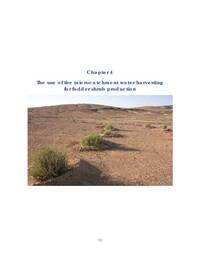The use of the microcatchment water harvesting for fodder shrub production

Authors:
The Badia constitutes about 90% of the total land area of Jordan, which is 89 342 km2. Its average annual rainfall is < 200 mm. The area with annual rainfall of 100–200 mm is considered the promising rangeland for rehabilitation. The Badia (part of the rangeland) supplies the livestock sector with about 20% of forage needs, while all the other sources provide the sector with only about 5% of forage.
Fodder shrubs in the low rainfall areas are subject to water shortage, overgrazing, and coppicing. Within the rangeland, 1 ha of shrubs produces about 0.5 t of fresh forage and increases the feed productivityas compared to the pasture without shrubs. Fodder shrub plantations, in addition to their role in range protection, have increased productivity by 500% as compared to unprotected rangeland (Ministry of Agriculture, 2005).
